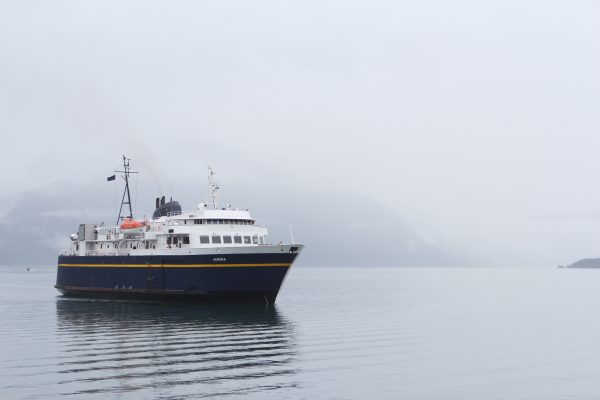
The Alaska Marine Highway System will operate at minimum levels this winter. That’s according to an announcement from the Department of Transportation that says the COVID-19 virus has cut deeply into the fleet’s farebox revenue.
State transportation spokesman Sam Dapcevich couldn’t immediately say Monday how much the system had lost due to the pandemic.
“But we are down quite dramatically,” he told CoastAlaska. “So, taking that into account, this was the best that we could do for providing service.”
Seven vessels will operate between October and next June. There will be some wide gaps in service. In most cases, only one ferry will be assigned to each route with no slack in the system.
“To me, it feels like a mobster breaking somebody’s knees and then blaming them for falling down,” Malena Marvin of Petersburg said of the reduced service. “I think a lot of communities feel about what’s happening to the ferries right now.”
Marvin started Ferries Move Alaska! an active Facebook group that’s garnered more than 4,500 followers in recent months.
How many sailings each community will receive isn’t clear. That’s because the state hasn’t released a draft schedule and doesn’t plan to this year. Rather, it’s giving residents this week to comment on a rough operational plan before it finalizes a winter schedule.
Usually, Marvin notes, the Marine Highway releases a draft schedule and holds a teleconference public hearing for affected coastal communities on its precise plans for the season.
RELATED: Border woes: When Canada says no
“We have several weeks to kind of find time to look at the schedule and try to understand how it’s going to be serving the communities,” she said.
DOT officials concede it’s a break from tradition with less public outreach.
“It’s not the same as our usual process,” Dapcevich said in a follow up statement, “but we needed to improvise due to the pandemic, low traffic levels, and the associated decline in revenue.”
Here’s what is known: the ferry Aurora’s return to service is being delayed from October until mid-April. That’s because the state says it needs more steelwork than previously thought.
RELATED: LeConte ferry crew member tests positive for COVID-19
Southeast villages of Hoonah, Gustavus, Angoon, Pelican and Tenakee Springs will see a nearly two-month winter gap without service while the ferry LeConte is being overhauled in mid-February.
And some other villages such as Ouzinkie and Port Lions on Kodiak Island have been eliminated from the winter schedule altogether. So has service to Prince Rupert, B.C. as well as Chenega Bay, Tatitlek, Valdez and Seldovia.
Also of note: neither of the state’s newest vessels, the $120 million Alaska Class Ferries, aren’t included in the plan.
The Tazlina is due to get new side doors. It’s not clear when its sister ship Hubbard will finally enter revenue service. The deadline to comment is Friday afternoon by emailing: dot.amhs.comments@alaska.gov.
Jacob Resneck is CoastAlaska's regional news director in Juneau.




